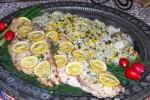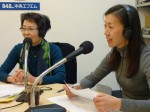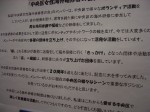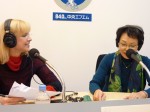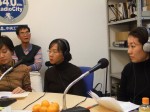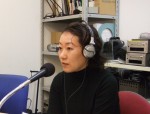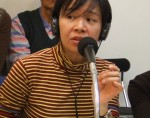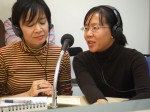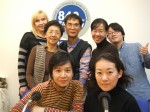I don’t know why, but mostly sushi chefs are men. Women work at sushi restaurants but they are waitresses or cashiers. So almost all of those who make sushi are men.
However there is a restaurant which defy the common wisdom of sushi. It’s called “Nadeshico Sushi” which opened in Akihabara on October 1, 2010. “Nadeshico (Nadeshiko)” is originally a kind of flower and it has become a compliment to the beauty of Japanese women. So the name of Nadeshico Sushi represents that beautiful women make sushi.
誰が決めたか分かりませんが、お寿司屋の板前さんは、ほとんどが男性ですよね。女性は働いているものの、ホールやレジだけで、カウンターの向こう側にいるのは、ほぼ100%男性と言っても過言ではないでしょう。
しかし、そんな伝統を覆したお店があります。昨年10月1日にオープンした、秋葉原にある「なでしこ寿司」です。その名の通り、お寿司をにぎるのは見目麗しき女性たちです。今週は、そんな女性たちが握るお寿司屋さんのご紹介です。

It’s along the Kanda-Myojin Street, near JR Akihabara Station. Nadeshico Sushi is located on the second floor of a building which has a crane machine hall downstairs (red sign).
JR秋葉原駅を出て中央通りを上野方面に進み、神田明神通りを左折すると、少し行ったところに「秋葉原クレーン研究所」と書いてある赤い看板が見えます。その真上に「なでしこ寿司」さんがあります。
お店をのぞいてみると・・・
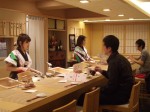
Actually girls are over the counter! 確かに、カウンターの向こう側に女性が!
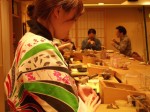
Her name is Rie, a sushi chef who’s been working there for about 3 months since it opened. I tried sushi which made by a girl for the first time in life. Sushi rice was a little bit warm, at body temperature.
オープニングメンバーで、板前歴3ヶ月とちょっとの「りえ」さんに握っていただきました。ラジオをお聴きの皆さんは、音声でこのもようをお聴きいただけたと思います。生まれて初めての、女性に握ってもらったお寿司は、シャリが人肌くらいに温かかったです。
I forgot to take photos of sushi so I borrowed some from Nadeshico Sushi. Sushi dishes that were made by girls are like a picture below!
食べるのに夢中で、肝心のお寿司の写真を撮り忘れてしまいました(涙)彼女たちが握るお寿司、こんな感じです!
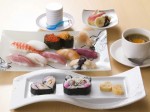
It’s called “Omakase” (Dishes of the chef’s choice) and available at ¥3,000. Of course you can order just one sushi. A master chef (male) who used to work at a luxury sushi restaurant prepares fish, rice and other ingredients.
名付けて「おまかせ」。にぎり10貫、デコ巻き(手前のパンダとハートの巻寿司)、たまご焼き、茶碗蒸し、味噌汁、フルーツ盛り合わせで、しめて3000円です。もちろん、お寿司は1貫から注文できます。ちなみにネタやシャリなどの仕込みは、高級寿司店で長らく板前をつとめた男性の料理長により行われています。なので、味は抜群です!
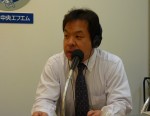
Kazuya Nishikiori, a producer of “Nadeshico Sushi”. He lamented over the bad employment conditions for women and wanted to create jobs for them. He had an eye on sushi making because there was no female sushi chef in Japan. He thought that there is much room for women to edge into the sushi world. That’s the reason Nishikiori opened a female sushi restaurant.
寿司界の常識を覆した「なでしこ寿司」をプロデュースしたのは、プロフィティ株式会社社長の錦織和也さんです。
錦織さんは、女性の雇用先が少ないことを嘆き、自ら優秀な女性の受け皿を作ろうと考えました。その際、女性がもともと多く働いている分野よりも、女性がほとんどいなかった分野の方が、今後の可能性が大きいと錦織さんは踏み、”板前さんが全員女性”のお寿司屋さんを作ったということです。すごい発想の転換ですよね!
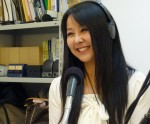
And we had one more guest. Yan Yi fei (Rebecca), a beautiful and intelligent woman from China. She works at Nadeshico Sushi and can speak 3 languages such as Chinese, English and Japanese!
そして、今週のもう一人のゲストです。才色兼備とはこのことを言うんですね〜中国出身で、なでしこ寿司で働いている、閻宜菲(えん・ぎひ)さんです。中国語はもちろんのこと、日本語はネイティブレベル、そして英語もめちゃくちゃ堪能なんです。ラジオをお聴きいただいた方は、すでにご存知ですね!
 *Yan, at right in photo. 右が閻さん (Nov.1, 2010 2010年11月1日)
*Yan, at right in photo. 右が閻さん (Nov.1, 2010 2010年11月1日)
I met her for the first time in last November at the sushi restaurant. They opened a sushi making class and she was welcoming some foreigners. I saw her talking to them in English and I thought that she must be a Japanese fluent speaker of English. But someone told me that she is Chinese! I was really surprised at it because she was talking to her coworkers in fluent Japanese.
閻さんとは、私は昨年11月の「お寿司作り体験」で初めて出会いました。そこには外国人も何人かいて、彼らと英語で会話をしていた閻さんを見て、てっきり”英語の上手な日本人”だと思っていたら、何と中国出身だと聞いて、ものすごくビックリしました!
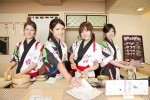
There’re many women gifted with both wits and beauty at the restaurant. Enjoy wonderful sushi dishes and talking with beautiful sushi chefs!
お店には、閻さんのように英語や中国語が堪能な才色兼備たちが勢揃いです!彼女たちが握ったお寿司をいただきながら、カウンター越しに会話も楽しめるお店「なでしこ寿司」。ぜひ足を運んでみて下さいね!
If you want to learn more about Nadeshico Sushi, watch this! *from 4’20” until 7’05
もっとよく「なでしこ寿司」をお知りになりたい方は、下の映像をご覧下さい(4分20秒〜7分5秒)
[youtube]http://www.youtube.com/watch?v=PtKE6Cirrws[/youtube]


